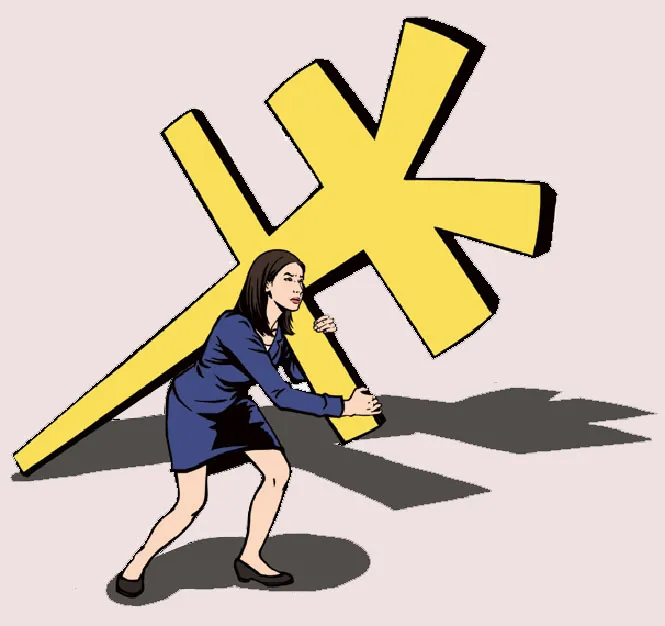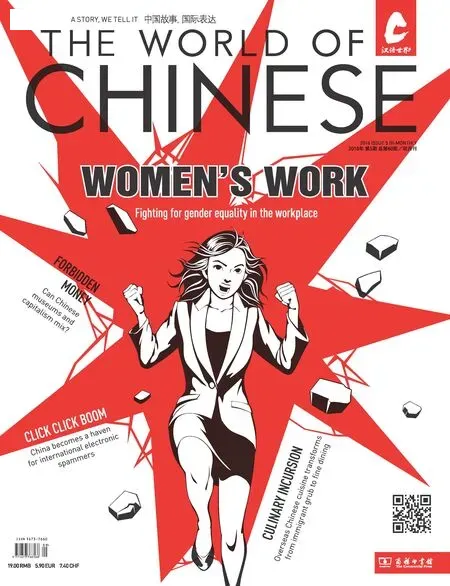WOMEN'S WORK INVOICE:1/2 SKY
WOMEN'S WORK INVOICE:1/2 SKY
What the women of China earn, what they deserve, and what they're missing
“ 半边天”遭遇“天花板”:实现职场性别平等,从改变社会观念开始。
GUlDELlNES, LAWS, STATUTES, POLlcY STATEMENTS-THE STRUcTURE FOR FEMALE EQUALlTY lN THE WORkPLAcE lS THERE. BUT lS lT WORklNG? cHlNA SUFFERS MANY OF THE SAME ETHlcAL AND PRAcTlcAL TRlBULATlONS OF GENDER EQUALlTY lN THE OFFlcE AS ELSEWHERE lN THE WORLD, BUT THE cHlNESE WORkPLAcE lS A VERY SPEclAL MONSTER. AS cHlNA BUlLDS FOR A cENTURY OF SUccESS, THE cONcEPT OF EQUAL PAY FOR EQUAL WORk FOR WOMEN SEEMS TO TAkE A BAck SEAT, AND TRUMPlNG TRADlTlONAL GENDER ROLES cAN BE DlFFlcULT, ESPEclALLY lN A NEWLY-URBANlZED EcONOMY THAT HASN'T QUlTE SETTLED. AND, OF cOURSE, BEYOND THE QUESTlON OF DlScRlMlNATlON lS ONE OF HARASSMENT;cHANGlNG LAWS MEAN NOTHlNG WHEN MlNDS REMAlN STUBBORNLY STAGNANT. THE 21ST cENTURY EcONOMY HAS BEEN DEFlNED BY THE “cHlNESE MlRAcLE”, AND THE WOMEN WHO SHAPED lT WANT WHAT'S DUE.
If you're a woman in China,statistically, you earn about two-thirds of the pay your male peers get—that is,if you live in a city. In the countryside that proportion drops to just over half. Those fgures come from a survey by the All China Women's Federation,though one has to wonder about fgures from an organization which has been pilloried by some academics for perpetuating the “leftover woman”trope (that any woman in her late 20s is reaching a marriage use-by date).
All of this illustrates the point that at both an institutional and individual level China remains very much a man's world—and this is very apparent in workplaces. However, the ways in which gender issues affect salaries can be complicated.
First and foremost, when calculating salary differences, it is important to consider the jobs themselves. While a company may point to the fact its female workforce receives a salary calculated by the same standards as the male employees, it may overlook the number of women in well-paid roles. The World Economic Forum's Global Gender Gap report in 2015 found that only 18 percent of Chinese companies have women in top management roles.
There are, of course, industries in which women are well represented. A 2015 International Labor Organization(ILO) report focused on the Asia Pacifc found that in China women had come to dominate four service sectors: hotels and catering, fnancial intermediation, education, and health and social welfare.
But are these really the areas women should feel lucky to dominate?
“The analysis of average earnings by occupation and sector suggests a stronger likelihood on the existence of a gender pay gap,” the report notes. “In hotels and catering services and the health, social securities, and social welfare sectors—two of the four female-dominated sectors in 2012—the average (annual) earnings for business service personnel lay below average at 29,500 RMB and 37,600 RMB in 2013.” For reference, the national average was 45,100 RMB.
No doubt, things are in many ways better than they were in the past. China's urbanization process is an economic boon to most. But it would seem the benefts of this societal transition haven't been spread evenly. The ILO report noted that “while the move out of agricultural work may have resulted in some improvements in the earnings of women and men,women tend to dominate in the lowest-paying occupations.”
As Lü Pin, a feminist media commentator and activist points out, these kinds of gender discrepancies are diffcult because they go beyond any easily identifable root causes. “For those of us trying to make change,pinning down the cause is the most important thing. We're concerned with how to stop these [inequalities] from happening.”
“With regard to the pay disparity, it's defnitely linked to basic gender-based discrimination, but institutions can make rules to prevent discrimination,that goes without question. In other countries they also have such rules,and they have to consider many factors,” Lü says.
Despite the fact that China's constitution specifcally prohibits gender discrimination in hiring, the nuts and bolts of this policy prove diffcult to implement and often result in misguided policies designed to “protect” women which instead exclude them.
The extent to which discrimination is responsible for the persistent gender pay gap is contentious. Many scholars agree discrimination plays a role, but it is incredibly diffcult to make any concrete assertions from the available data. Some reports say it is the overwhelming cause, others downplay its signifcance.
Worryingly, there are reasons to think the situation might be getting worse.
The ILO report states that despite some legislative achievements, “in recent years, there appears to be a re-emergence of gender stereotypes related to women's and men's roles in early capitalist or market economy societies, i.e. men as breadwinners and women as caregivers.”
This is supported by plenty of casual observations. Simply by opening a newspaper or pulling up an employment-wanted section of a website, anyone can come acrossa wide array of advertisements for jobs that specifcally request men or women for positions that ought to have no gender requirement. For years the proportion of advertisements specifying male applicants had been on the decrease, but in 2010 that trend bottomed out and it started to rise once again. The ILO report notes that it's particularly pronounced for new graduates and corresponds with a tougher job market, which most economists are predicting for China over the coming few years.
For quite some time, there have been reasons to cast doubt on the assumption that economic development would automatically mean improvements in women's rights. In 2011, the All China Women's Federation released the results of a large survey conducted alongside China's bureau of statistics. In the section on gender attitudes, there were some encouraging fndings: 83 percent agreed that women were just as capable as men, and 88 percent believed that men should shoulder some of the housework. 86 percent felt that there needed to be proactive moves to encourage gender equity.
But then, notably, 61 percent of men and 54 percent of women felt that “the feld for men is in public and the domain for women is within the household.”
This result is particularly concerning when measured against the results of that question when it was asked ten years earlier. Compared to a decade earlier, 7.7 percent more men in 2011 believed that a woman's place is in the home, and the number of women expressing that same view had increased by 4.4 percent.
As China's population ages and society fnds itself lacking in young labor—the one-child policy having already fallen by the wayside—it seems likely that pressures on women to give birth and care for the elderly will increase, with a corresponding impact on their earning potential.
One concluding thought to keep independent-minded Chinese women up late at night: will Chinese attitudes toward career-focused“leftover women” become more or less forgiving when jobs for men are scarcer and the economy demands more babies? The answer, hopefully, is not as simple as it sounds.
- DAVlD DAWSON
54 PERcENT OF WOMEN FELT THAT “THE FlELD FOR MEN lS lN PUBLlc AND THE DOMAlN FOR WOMEN lS WlTHlN THE HOUSEHOLD”


